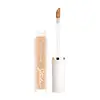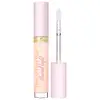Strokes Spot Veil Concealer Versus Too Faced Born This Way Ethereal Light Illuminating Smoothing Concealer
What's inside
What's inside
 Key Ingredients
Key Ingredients

 Benefits
Benefits

 Concerns
Concerns

No concerns
 Ingredients Side-by-side
Ingredients Side-by-side

Water
Skin ConditioningCyclopentasiloxane
EmollientTrimethylsiloxyphenyl Dimethicone
Trimethylsiloxysilicate
EmollientIsononyl Isononanoate
EmollientGlycerin
HumectantCaprylic/Capric Triglyceride
MaskingSorbitan Olivate
EmulsifyingPolyglyceryl-4 Isostearate
EmulsifyingPhenoxyethanol
PreservativeCetyl PEG/PPG-10/1 Dimethicone
EmulsifyingHexyl Laurate
EmollientTriethoxycaprylylsilane
Euphorbia Cerifera Cera
AstringentCaprylyl Glycol
EmollientTocopheryl Acetate
AntioxidantAloe Barbadensis Leaf Extract
EmollientXanthan Gum
EmulsifyingCaffeine
Skin ConditioningCoffea Arabica Seed Extract
MaskingSodium Hyaluronate
HumectantLecithin
EmollientCI 77891
Cosmetic ColorantCI 77492
Cosmetic ColorantCI 77491
Cosmetic ColorantCI 77289
Cosmetic ColorantCI 77288
Cosmetic ColorantWater, Cyclopentasiloxane, Trimethylsiloxyphenyl Dimethicone, Trimethylsiloxysilicate, Isononyl Isononanoate, Glycerin, Caprylic/Capric Triglyceride, Sorbitan Olivate, Polyglyceryl-4 Isostearate, Phenoxyethanol, Cetyl PEG/PPG-10/1 Dimethicone, Hexyl Laurate, Triethoxycaprylylsilane, Euphorbia Cerifera Cera, Caprylyl Glycol, Tocopheryl Acetate, Aloe Barbadensis Leaf Extract, Xanthan Gum, Caffeine, Coffea Arabica Seed Extract, Sodium Hyaluronate, Lecithin, CI 77891, CI 77492, CI 77491, CI 77289, CI 77288
Water
Skin ConditioningHydrogenated Didecene
Skin ConditioningC9-12 Alkane
SolventGlycerin
HumectantPolyglyceryl-4 Isostearate
EmulsifyingTrimethylsiloxysilicate
EmollientLauryl Polyglyceryl-3 Polydimethylsiloxyethyl Dimethicone
Skin ConditioningCaprylic/Capric Triglyceride
MaskingPolypropylsilsesquioxane
Isohexadecane
EmollientVp/Hexadecene Copolymer
Cocos Nucifera Fruit Juice
EmollientCocos Nucifera Oil
MaskingHelianthus Annuus Seed Oil
EmollientAloe Barbadensis Leaf Juice
Skin ConditioningRosmarinus Officinalis Leaf Extract
AntimicrobialRhododendron Ferrugineum Extract
MaskingAesculus Hippocastanum Extract
AntioxidantRaphanus Sativus Seed Extract
Skin ConditioningArgania Spinosa Kernel Oil
EmollientSodium Hyaluronate
HumectantCaprylyl Glycol
EmollientOctyldodecanol
EmollientStearalkonium Hectorite
Gel FormingSqualane
EmollientTripeptide-1
Skin ConditioningCoco-Caprylate/Caprate
EmollientCitric Acid
BufferingXanthan Gum
EmulsifyingButylene/Ethylene/Styrene Copolymer
Trisodium Ethylenediamine Disuccinate
Ethylene/Propylene/Styrene Copolymer
Propylene Carbonate
Solvent1,2-Hexanediol
Skin ConditioningHydrogenated Lecithin
EmulsifyingLecithin
EmollientSodium Chloride
MaskingDisteardimonium Hectorite
StabilisingHydrogenated Styrene/Isoprene Copolymer
Fructose
HumectantTocopherol
AntioxidantTocopheryl Acetate
AntioxidantPentaerythrityl Tetra-Di-T-Butyl Hydroxyhydrocinnamate
AntioxidantSodium Benzoate
MaskingPotassium Sorbate
PreservativePhenoxyethanol
PreservativeSodium Dehydroacetate
PreservativeCI 77891
Cosmetic ColorantCI 77491
Cosmetic ColorantCI 77492
Cosmetic ColorantCI 77499
Cosmetic ColorantWater, Hydrogenated Didecene, C9-12 Alkane, Glycerin, Polyglyceryl-4 Isostearate, Trimethylsiloxysilicate, Lauryl Polyglyceryl-3 Polydimethylsiloxyethyl Dimethicone, Caprylic/Capric Triglyceride, Polypropylsilsesquioxane, Isohexadecane, Vp/Hexadecene Copolymer, Cocos Nucifera Fruit Juice, Cocos Nucifera Oil, Helianthus Annuus Seed Oil, Aloe Barbadensis Leaf Juice, Rosmarinus Officinalis Leaf Extract, Rhododendron Ferrugineum Extract, Aesculus Hippocastanum Extract, Raphanus Sativus Seed Extract, Argania Spinosa Kernel Oil, Sodium Hyaluronate, Caprylyl Glycol, Octyldodecanol, Stearalkonium Hectorite, Squalane, Tripeptide-1, Coco-Caprylate/Caprate, Citric Acid, Xanthan Gum, Butylene/Ethylene/Styrene Copolymer, Trisodium Ethylenediamine Disuccinate, Ethylene/Propylene/Styrene Copolymer, Propylene Carbonate, 1,2-Hexanediol, Hydrogenated Lecithin, Lecithin, Sodium Chloride, Disteardimonium Hectorite, Hydrogenated Styrene/Isoprene Copolymer, Fructose, Tocopherol, Tocopheryl Acetate, Pentaerythrityl Tetra-Di-T-Butyl Hydroxyhydrocinnamate, Sodium Benzoate, Potassium Sorbate, Phenoxyethanol, Sodium Dehydroacetate, CI 77891, CI 77491, CI 77492, CI 77499
 Reviews
Reviews

Ingredients Explained
These ingredients are found in both products.
Ingredients higher up in an ingredient list are typically present in a larger amount.
This ingredient is an emollient, solvent, and texture enhancer. It is considered a skin-softener by helping the skin prevent moisture loss.
It helps thicken a product's formula and makes it easier to spread by dissolving clumping compounds.
Caprylic Triglyceride is made by combining glycerin with coconut oil, forming a clear liquid.
While there is an assumption Caprylic Triglyceride can clog pores due to it being derived from coconut oil, there is no research supporting this.
Learn more about Caprylic/Capric TriglycerideCaprylyl Glycol is a humectant and emollient, meaning it attracts and preserves moisture.
It is a common ingredient in many products, especially those designed to hydrate skin. The primary benefits are retaining moisture, skin softening, and promoting a healthy skin barrier.
Though Caprylyl Glycol is an alcohol derived from fatty acids, it is not the kind that can dry out skin.
This ingredient is also used as a preservative to extend the life of products. It has slight antimicrobial properties.
Learn more about Caprylyl GlycolCi 77491 is also hydrated iron III oxide. It's sole purpose is to give a red/pink hue to products.
Iron III oxides are classified as inorganic chemicals for coloring.
Synthetically created Ci 77491 is considered safer than those naturally found. This is because the synthetically created version may contain less impurities. Iron oxides are generally non-toxic and non-allergenic.
Learn more about CI 77491Ci 77492 is also hydrated iron III oxide. It's sole purpose is to give a yellow hue to products.
Iron III oxides are classified as inorganic chemicals for coloring.
Synthetically created Ci 77492 is considered safer than those naturally found. This is because the synthetically created version may contain less impurities. Iron oxides are generally non-toxic and non-allergenic.
Learn more about CI 77492Ci 77891 is a white pigment from Titanium dioxide. It is naturally found in minerals such as rutile and ilmenite.
It's main function is to add a white color to cosmetics. It can also be mixed with other colors to create different shades.
Ci 77891 is commonly found in sunscreens due to its ability to block UV rays.
Learn more about CI 77891Glycerin is already naturally found in your skin. It helps moisturize and protect your skin.
A study from 2016 found glycerin to be more effective as a humectant than AHAs and hyaluronic acid.
As a humectant, it helps the skin stay hydrated by pulling moisture to your skin. The low molecular weight of glycerin allows it to pull moisture into the deeper layers of your skin.
Hydrated skin improves your skin barrier; Your skin barrier helps protect against irritants and bacteria.
Glycerin has also been found to have antimicrobial and antiviral properties. Due to these properties, glycerin is often used in wound and burn treatments.
In cosmetics, glycerin is usually derived from plants such as soybean or palm. However, it can also be sourced from animals, such as tallow or animal fat.
This ingredient is organic, colorless, odorless, and non-toxic.
Glycerin is the name for this ingredient in American English. British English uses Glycerol/Glycerine.
Learn more about GlycerinLecithin is a term for a group of substances found in the cell membranes of plants, animals, and humans. They are made up of mixture of phospholipids.
This ingredient has emollient and emulsifying properties.
As an emollient, lecithen helps soften the skin and creates a barrier to keep moisture in.
As an emulsifier, it also helps prevent water and oil ingredients from separating. Lecithin can also help ingredients be better absorbed by the skin.
This is because the phospholipids in lecithin produce liposomes. Liposomes help other ingredients get through the skin barrier.
Depending on the source of this ingredient, lecithin may not be fungal acne safe. This is because some sources of lecithin come from soybean oil, which may feed the malassezia yeast that feeds fungal acne.
We recommend reaching out to the brand you are purchasing from to inquire about the source of their lecithin.
Some other names for this ingredient include soy lecithin and deoiled soy lecithin.
Learn more about LecithinPhenoxyethanol is a preservative that has germicide, antimicrobial, and aromatic properties. Studies show that phenoxyethanol can prevent microbial growth. By itself, it has a scent that is similar to that of a rose.
It's often used in formulations along with Caprylyl Glycol to preserve the shelf life of products.
This ingredient is an emulsifer and stabilizer. It comes from isostearic acid and polyglycerin.
As an emulsifier, it helps blend oil and water to improve texture, spreadbility, and application.
Due to it being derived from isostearic acid, this ingredient may not be fungal acne safe.
Learn more about Polyglyceryl-4 IsostearateSodium Hyaluronate is hyaluronic acid's salt form. It is commonly derived from the sodium salt of hyaluronic acid.
Like hyaluronic acid, it is great at holding water and acts as a humectant. This makes it a great skin hydrating ingredient.
Sodium Hyaluronate is naturally occurring in our bodies and is mostly found in eye fluid and joints.
These are some other common types of Hyaluronic Acid:
Learn more about Sodium HyaluronateTocopheryl Acetate is AKA Vitamin E. It is an antioxidant and protects your skin from free radicals. Free radicals damage the skin by breaking down collagen.
One study found using Tocopheryl Acetate with Vitamin C decreased the number of sunburned cells.
Tocopheryl Acetate is commonly found in both skincare and dietary supplements.
Learn more about Tocopheryl AcetateThis silicone is an emollient. Emollients create a thin film on the skin to prevent moisture from escaping.
It is not soluble in water and helps increase water-resistance in products.
According to a manufacturer, it can blend seamlessly with silicone oils, such as Cyclopentasiloxane.
Learn more about TrimethylsiloxysilicateWater. It's the most common cosmetic ingredient of all. You'll usually see it at the top of ingredient lists, meaning that it makes up the largest part of the product.
So why is it so popular? Water most often acts as a solvent - this means that it helps dissolve other ingredients into the formulation.
You'll also recognize water as that liquid we all need to stay alive. If you see this, drink a glass of water. Stay hydrated!
Learn more about WaterXanthan gum is used as a stabilizer and thickener within cosmetic products. It helps give products a sticky, thick feeling - preventing them from being too runny.
On the technical side of things, xanthan gum is a polysaccharide - a combination consisting of multiple sugar molecules bonded together.
Xanthan gum is a pretty common and great ingredient. It is a natural, non-toxic, non-irritating ingredient that is also commonly used in food products.
Learn more about Xanthan Gum